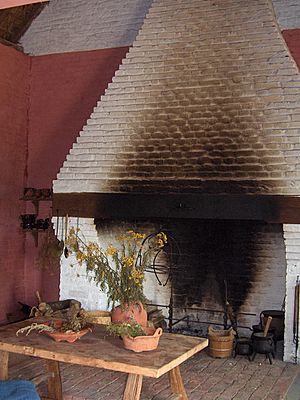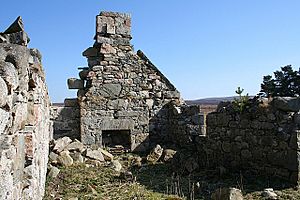Hearth tax facts for kids
A hearth tax was a special property tax used in some countries during the Middle Ages and early modern period. It was a tax on each hearth (fireplace) in a home. This meant that the more fireplaces a house had, the more tax its owner paid. It was one of the first types of progressive tax, meaning people with more wealth paid more.
Hearth taxes were used in the Byzantine Empire starting in the 800s. France and England began using them in the 1300s. Later, in the 1600s, Scotland and Ireland also started collecting hearth taxes.
Contents
History of the Hearth Tax
Byzantine Empire's Hearth Tax
In the Byzantine Empire, a tax on hearths was called kapnikon. It was first clearly mentioned during the rule of Nicephorus I (802–811 AD). However, it seems this tax was already old and well-known, possibly even dating back to the 600s AD. The kapnikon was a tax that every household had to pay, even poor families.
France's Hearth Tax
In the 1340s, the King of France needed a lot of money for his personal spending. This included money for weddings, gifts, keeping up his palace, travel, and clothes. This spending used up all the royal income. The fouage (which means "hearth tax" in Latin) was a tax based on households. Towns usually paid it as one big amount, which they collected however they chose. This tax became common in the 1300s when the king's money could not cover the rising costs of wars and government workers. Fouages were especially collected in 1342 and 1349.
England's Hearth Tax
Middle Ages Tax
In Anglo-Saxon England, the term "hearth-penny" was used for Peter's pence, which was a different kind of tax.
Stuart Period Tax (1662-1689)
In England, the hearth tax was also known as hearth money, chimney tax, or chimney money. The Parliament of England introduced it in 1662 to help support the Royal Household of King Charles II. After the monarchy was brought back in 1660, Parliament decided the Royal Household needed £1,200,000 each year. The hearth tax was added to make up for any money they were short.
It was thought to be easier to count fireplaces than people, as fireplaces stayed in one place. This type of tax was new to England but had been used in other countries. It caused a lot of debate, but economist Sir William Petty supported it. The bill passed Parliament on May 19, 1662. The first payment was due on September 29, 1662, which was Michaelmas.
People had to pay one shilling for every fireplace or stove in their homes. This payment was due twice a year: on Michaelmas (September 29) and on Lady Day (March 25). So, the total tax was two shillings per hearth or stove per year. The first version of the law did not say if owners or renters should pay, and it could have been a big problem for poor people because there were no exemptions. The law was later changed so that the person living in the house paid the tax. More changes were made to include exemptions, so many poorer people did not have to pay.
| Exemptions from the hearth tax |
|---|
| Not paying Poor or Church Rates |
| Living in a house, building, or land worth less than 20 shillings (£1) rent per year |
| Having assets worth less than £10 |
| Private ovens, furnaces, kilns, and blowing houses |
| Hospitals and almshouses with less than £100 per year in income |
To get an exemption, a minister, a churchwarden, or an overseer of the poor, along with two Justices of the Peace, had to sign a certificate. From 1664, anyone whose home had more than two hearths had to pay the tax, even if they were otherwise exempt. Changes were also made to stop people from avoiding the tax.
The money collected in the first year was less than expected. So, from 1663, the names and number of hearths had to be listed, even for those who did not have to pay. This extra information is very helpful for historians and researchers today. However, details of householders who did not pay the tax were not always recorded in later years.
The way the hearth tax was collected changed over time:
- 1662 to 1664: Local police officers (petty constables) collected the tax, with help from local government.
- 1664 to 1665: Special "chimney-men" were hired to collect the tax.
- 1666 to 1669: The right to collect the tax was rented out to three London merchants for a fee.
- 1669 to 1674: A government office called "Agents for the Hearth Tax" oversaw collection by directly hired workers.
- 1674 to 1684: The tax collection was rented out again.
- 1684 to 1689: A special government group collected both the excise tax and the hearth tax.
The tax hit hardest those who lived in houses with many hearths. For example, in 1673-74, the Earl of Exeter had to pay for 70 hearths at Burghley House. But most people who paid the tax had only one or two hearths. A large number of households did not have to pay at all.
The hearth tax was very unpopular because tax collectors and local police could legally enter homes to count the hearths. Some people blocked up their chimneys to avoid the tax. If assessors found this, the tax was doubled. On July 31, 1684, a fire in Churchill, Oxfordshire, destroyed 20 houses and killed four people. It was caused by a baker who, to avoid the chimney tax, had knocked a hole from her oven to her neighbor's chimney. Sir Courtenay Pole, who helped create the tax, was criticized for making "the most annoying tax on the people that ever was known."
After the Glorious Revolution in 1688, the new rulers, William III and Mary II, agreed to get rid of the hearth tax in 1689. The English Parliament said it was:
not only a great oppression to the poorer sort, but a badge of slavery upon the whole people, exposing every man’s house to be entered into, and searched at pleasure, by persons unknown to him.
The end of the hearth tax and the signing of the Bill of Rights 1689 meant more legal protection for people's lives, freedom, and property in England. This helped the middle class grow at the start of the Industrial Revolution. This action also showed the end of long conflicts between the king and Parliament. It also ended the idea that English kings had any divine rights (God-given rights to rule). To make up for the lost tax money, new property taxes were put in place with very few exemptions.
Scotland's Hearth Tax
In 1690, the Parliament of Scotland approved a tax of 14 shillings on every hearth. Both landowners and renters had to pay it to raise money for the army. Only hospitals and poor people receiving charity from the church were exempt. This tax was collected from 1691 to 1695.
Ireland's Hearth Tax
Unlike England, which ended its Hearth Tax in 1689, Ireland kept it until the early 1800s. However, it was greatly changed in the late 1700s. The Sheriff of each county collected it twice a year, using lists of householders made by local Justices of the Peace. These lists were called the Hearth Money Rolls. They were organized by county, barony, parish, and townland.
Many attempts were made in Parliament to get rid of the tax or at least reduce how many households had to pay it. It was widely seen as "a shameful burden upon the poor farmer." In 1788, politicians like Thomas Conolly and John O'Neill argued that for many people, the yearly tax was too much. Henry Grattan agreed, saying, "The misery of their living... is the reason why they scarcely pay any tax but the hearth-money, and is likewise a reason why they should not even pay hearth-money."
Major changes to the hearth tax finally happened in 1793. Homes with only one hearth were made exempt if they had less than £10 in personal property or if their house and land were worth £5 or less. Later, in 1795, all one-hearth households became free from the tax. At the same time, the tax on houses with multiple hearths was increased. It was estimated that between 1.5 and 2 million people were freed from the hearth tax.
The original Hearth Money Rolls are no longer available. They were kept in the Four Courts in Dublin, but the building was destroyed by fire during the Irish Civil War in 1922. This fire also destroyed the Rolls and many census records for Ireland from 1821 to 1851. However, copies of some of the Rolls have survived.
Hearth Tax Research
Hearth tax records are very useful for historians because they are so complete and cover almost the whole country. Unlike other old tax records, the hearth tax also listed the names of people who did not have to pay. This helps researchers study all kinds of social groups, not just the wealthy.
Historians use hearth tax records to understand how wealth was spread among different social classes in various areas. They can group homes by the number of hearths to see patterns of wealth and poverty. Researchers have created national tables and maps to compare wealth levels between counties and even within parishes.
Since 2010, the Centre for Hearth Tax Research has been using digital tools to study and publish information about the hearth tax. In 2019, they launched "Hearth Tax Digital," a website that provides free access to names and analysis of how people and wealth were spread in towns and rural areas of England in the late 1600s. This website allows historians to search for names, places, and even words like "blind" or "seaman" along with the number of hearths. It helps them see how communities were organized, street by street, and understand the differences between rich and poor neighbors.
Another important part of hearth tax research involves "exemption certificates." These records list the names of householders who did not have to pay the tax. They help fill in gaps in other records, especially for poorer areas. By studying these certificates, researchers can better understand people who were below the tax limit and the words used to describe their property.
Organizations Studying Hearth Tax
The Centre for Hearth Tax Research is located at the University of Roehampton in London. Its main goal is to publish the best surviving hearth tax records for every county in England. This is a long-term project that will take many years.
The center started in 1995. Since 2000, with a grant from the Heritage Lottery Fund, all tax records stored in The National Archives have been put on microfilm. The center also works with the British Record Society to publish county volumes, including recent ones for Essex (2012), London and Middlesex (2014), Yorkshire East Riding (2016), and Bristol (2018). Upcoming volumes include Huntingdonshire, Norfolk, and Northamptonshire.
The British Academy and the Arts and Humanities Research Council (AHRC) have also supported the Hearth Tax Project. This funding helped organize an exhibition about poverty in Essex, which nearly 2,000 people visited.
The "Hearth Tax Digital" website, launched in 2019, is a result of teamwork between the Centre for Hearth Tax Research and the University of Graz in Austria. It is funded by the British Academy and the University of Roehampton. New information and analyses are constantly being added as more counties are completed. The center also has a blog, Hearth Tax Online, where they share activities, analyses, and guest posts about the Hearth Tax.
See also
 In Spanish: Fogaje para niños
In Spanish: Fogaje para niños
- Glass tax
- Brick tax
- Wallpaper tax
- Window tax
- Hut tax



